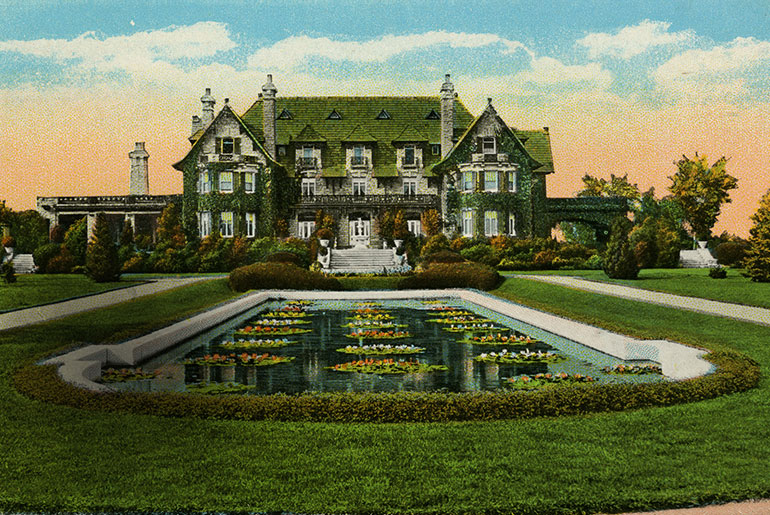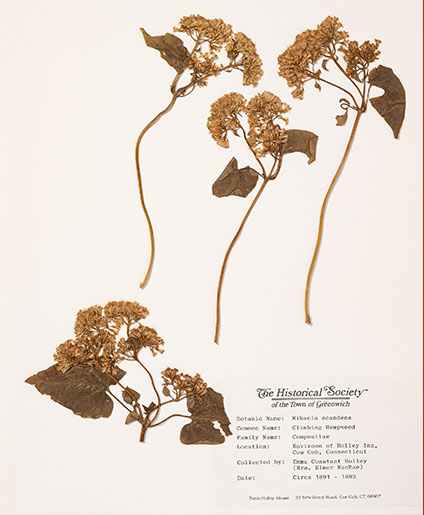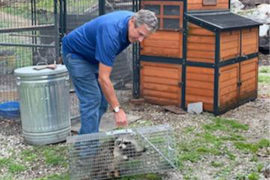The changing landscape of a place offers not only a tapestry of it but a narrative as well. So it is with “Beautiful Work: The Art of Greenwich Gardens and Landscapes,” on view through Sept. 5 at the Greenwich Historical Society. The exhibit surveys gardens ranging from majestic and manicured (Chelmsford, the home of industrialist Elon Huntington Hooker and wife Blanche Ferry Hooker) to the casually creative (the Bush-Holley House, home of the American Impressionist Cos Cob Art Colony and now part of the historical society) in some 60 photographs, landscape design and architectural drawings, books, magazines and paintings. (The show even contains an intriguing loan from the Smith College Historic Clothing Collection, an example of the blue chambray overalls for gardening that American women could order in 1918 from the Sears Roebuck catalog.) But while focusing on the town’s gardens, the show also charts the development of Greenwich itself.
“We happen to have a lot of objects that can tell a broader story,” says Maggie Dimock, the historical society’s curator of exhibitions and collections and the person responsible for an exhibit whose arches and pale-green palette are designed to place viewers in a garden setting.
The exhibit’s broader story, as the historical society’s new “Historic Garden & Landscape Guide” notes, begins with the Wiechquaeskeck, a Munsee-speaking group of the Lenape people, who cultivated and hunted on the land for centuries. Seeing themselves as one with a nature that belonged to everyone, the native peoples had a different relationship to the land, Dimock says, than the European settlers who arrived in the 17th century and began carving it up and farming it with the use of enslaved labor and hired hands. Throughout the 18th and 19th centuries, the rocky terrain nonetheless yielded corn, onions, potatoes and apples, particularly russet apples used in cider, and other crops that were intended for homegrown consumption as well as for the commercial markets of New York City.
But in the late 19th century, a shift occurred as those who made their wealth in the city began yearning for the country life in places like Greenwich and the English-, French- and Italian-style gardens that went with it. The period of 1890 to 1930, Dimock says, also coincided with the rise of landscape architecture as a field of study and a profession, one that would offer opportunities and challenges for women like the pioneering Beatrix Farrand — niece of the Gilded Age novelist Edith Wharton, herself the author of “Italian Villas and Their Gardens” and owner of the exquisitely landscaped estate The Mount in Lenox, Massachusetts. Farrand’s example would inspire Briarcliff Manor native Marian Cruger Coffin, who created the Seaside Garden for industrialist J. Kennedy Tod’s Innis Arden estate that was featured in the March 1920 issue of House and Garden (.35 cents) and that is now Greenwich Point Park, or Tod’s Point, in Old Greenwich. Among Coffin’s other notable commissions were the gardens at Winterthur, Henry Francis and Ruth du Pont’s Delaware estate, and some layouts for the New York Botanical Garden in the Bronx. The early women landscape architects triumvirate was completed by Ellen Biddle Shipman, who designed the Greenwich estate of lawyer Herbert L. Satterlee, The Orchards, along with that of Clark Williams, Live Oak, which was in the town’s Belle Haven section.
Landscape architecture was, Dimock says, a “mutable” profession dominated early on by men like Andrew Jackson Downing; Downing’s protégé Frederick Law Olmsted of Central Park fame; and architect Bryant Fleming, who refined the gardens for Chelmsford created by his mentor Warren H. Manning, an advocate for a more informal approach to gardens.
Those created at the Bush-Holley House were no less charming for their informality. Once the home of grist-mill owner David Bush, the house became a boardinghouse for artists and writers in the mid-19th century when it was acquired by Josephine and Edward Holley — a tradition continued by their daughter, the appropriately named Constant, and her husband, Elmer MacRae, one of the many American Impressionist painters associated with the site and what became known as the Cos Cob Art Colony.
“The Holley family had extensive vegetable gardens,” Dimock says. These included an Heirloom Vegetable Garden of tomatoes, cucumbers and sugar beets as well as fruit trees tended first by Edward and then by Elmer. There was also a Concord grape arbor and a flower garden of annuals and perennials beloved by pollinators and nurtured by Constant that included hollyhocks, foxglove, roses, peonies, poppies and catmint.
Perhaps the unsung heroine of the house was Constant, who besides running the place co-founded the Greenwich Garden Club in 1914 and became a respected floral designer, one who was invited to display her arrangements at the 1939 New York World’s Fair, Dimock says.
She also collected, dried and preserved 100 botanical specimens — including ferns, cattails, irises and dandelions — which the historical society rediscovered in the 1980s and has mounted on special herbarium paper. Some of these are part of the exhibit.
The historical society is the 2020 recipient of The Garden Club of America’s Zone Historic Preservation Commendation, which recognizes not only its sustained preservation of the national historic landmark Bush-Holley House site but also the restoration of its American Impressionist art colony gardens.
“Beautiful Work” will be accompanied by outdoor adult and family programs set amid those historical gardens, including a series of Tavern Markets and summer Concerts on the Lawn.
“Beautiful Work: The Art of Greenwich Gardens and Landscapes” will be on view in the exhibit gallery at the Greenwich Historical Society’s Museum & Library through Nov. 15. Visitors are encouraged to reserve tickets in advance at greenwichhistory.org/visit/.






